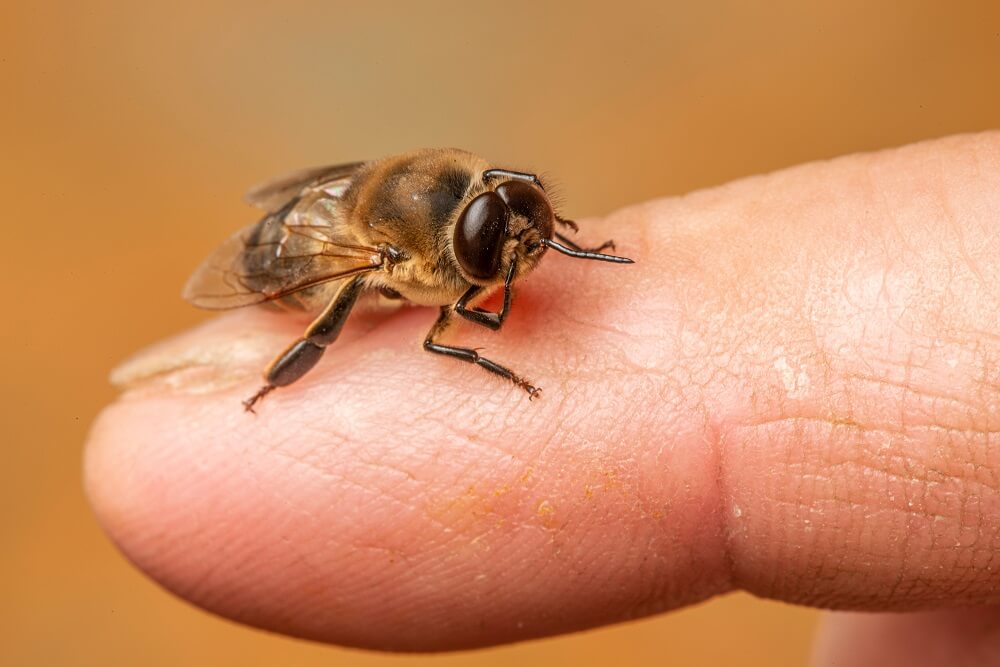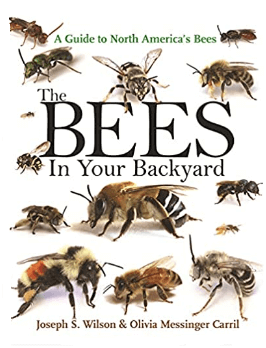Table of Contents:
What Are Drone Bees?
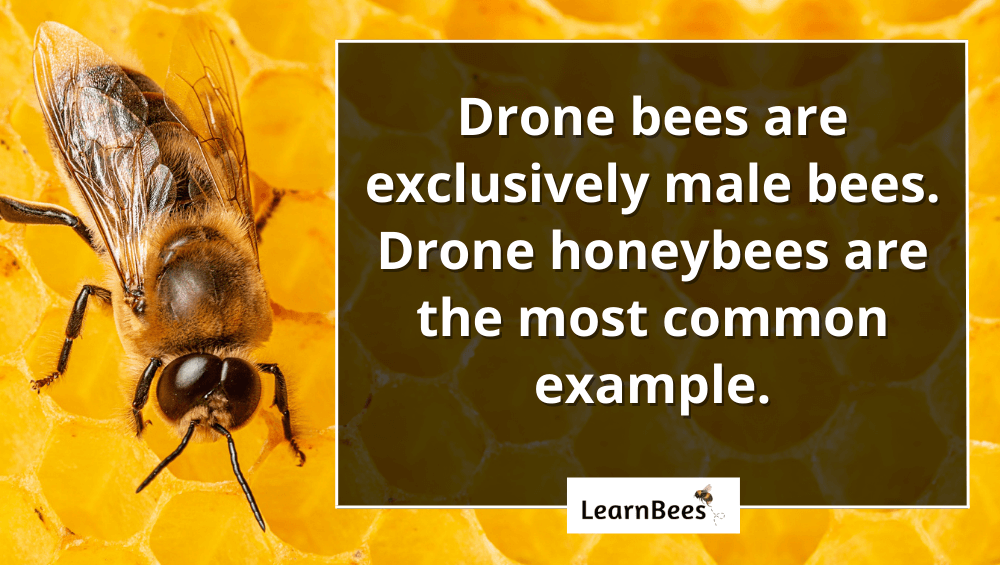
Drone bees are male honeybees.
More specifically, every honeybee hive has three roles:
- The queen bee
- The worker bees (female)
- The drone bees (male)
Drone honeybees can be tricky to spot when surrounded by thousands of other bees.
So how do you identify them?
Easy. By looking at their eyes.
Drone bees have massive eyes that touch each other. This comes in handy for helping them spot queens to mate with. In contrast, female bees have smaller eyes that don’t touch.
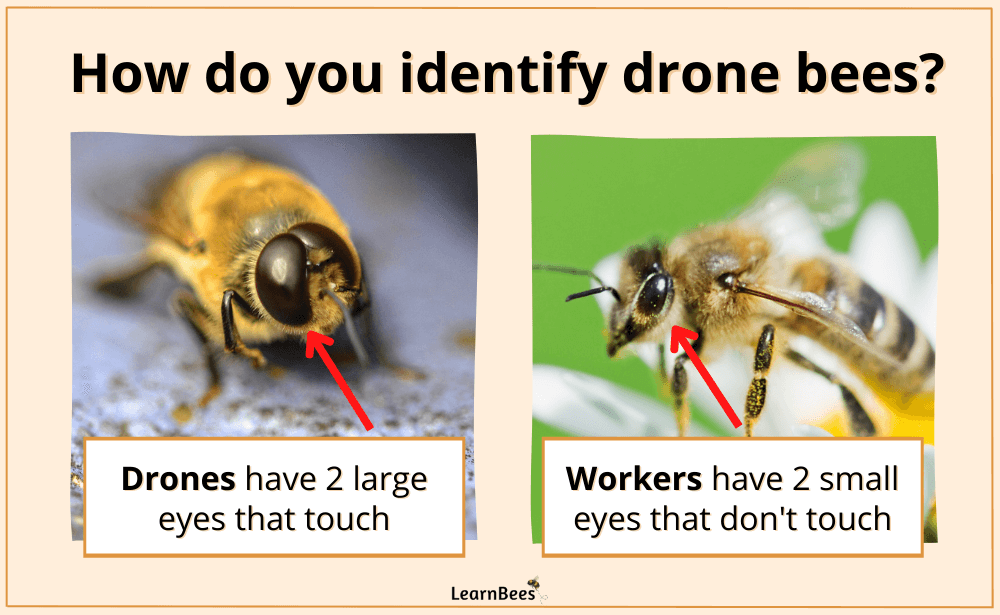
And here’s the thing:
Drone bees only make up a tiny portion of the honeybee hive.
Over 90% of the honeybee colony consists of female worker bees. There’s a single queen, thousands of worker honeybees, and usually only a couple hundred drones.
How come?
Because, unlike female worker bees, drones don’t perform any work around the hive. They don’t gather food. They don’t clean the nest. They don’t ward off potential intruders.
Instead, drone honeybees have one job, and they do it very well.
What Do Drone Bees Do?
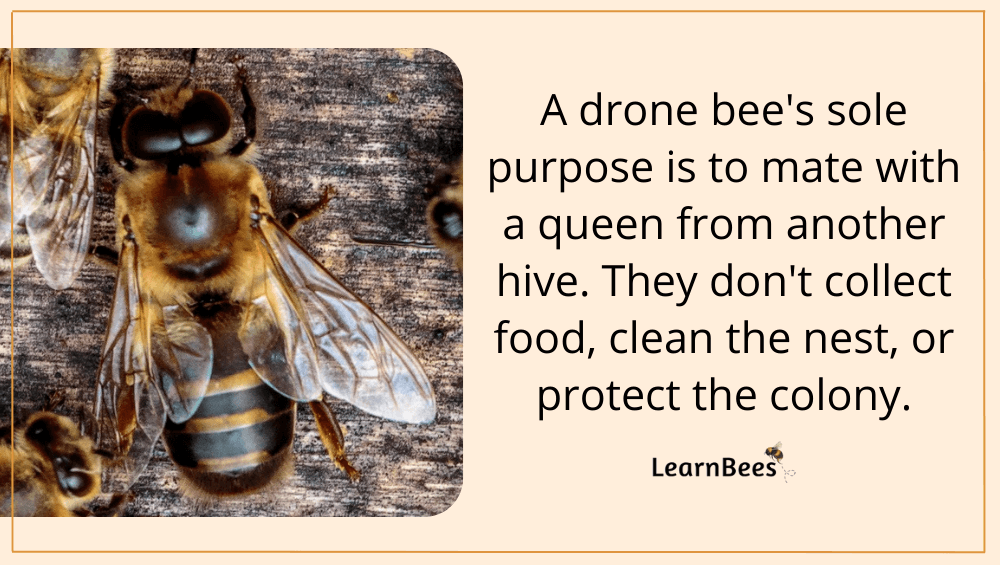
A drone bee’s sole purpose is to mate with a queen bee from another hive.
That’s it.
With that in mind, only the fastest drones actually get the chance to reach this goal. This is because hundreds of other drone bees are competing for the exact same thing.
How does this work?
It starts during the spring and summer, which is the prime mating season.
Drones leave their hives and begin huddling together in drone congregation areas. This cluster of buzzing male bees attracts the queen’s attention. As a result, she flies over to them and begins the reproduction process.
And here’s the kicker:
Out of hundreds of drone bees, only a handful will mate with the queen. Honeybee mating takes place in midair, so it’s all about speed.
And the competition is fierce.
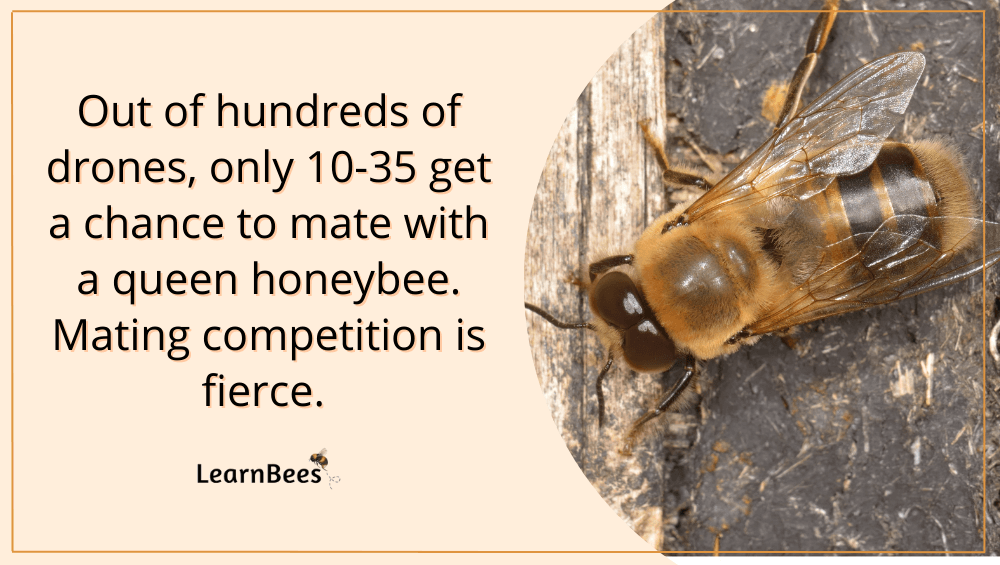
But let me be clear:
Drone bees don’t fight over the queen. Instead, they simply focus on flying fast enough to catch her. Mating only lasts a few seconds per drone, and then the queen moves on to the next drone until her mating flight is complete.
Now it’s worth mentioning:
Drone bees aren’t lazy.
Sure, worker bees do perform most of the hive duties, while drone bees mainly wait around until mating season.
But that doesn’t make them lazy. Instead, it means that drones perform precisely the role that nature gave them. Without their mating help, honeybees would cease to exist.
And the truth is?
Every bee has an assigned role that they’re happy to perform.
For example, drone honeybees don’t defend the hive because they weren’t designed to. They don’t even have stingers. Similarly, worker bees don’t mate because that’s not their job either.
That brings us to our next topic:
How Long Do Drone Bees Live?
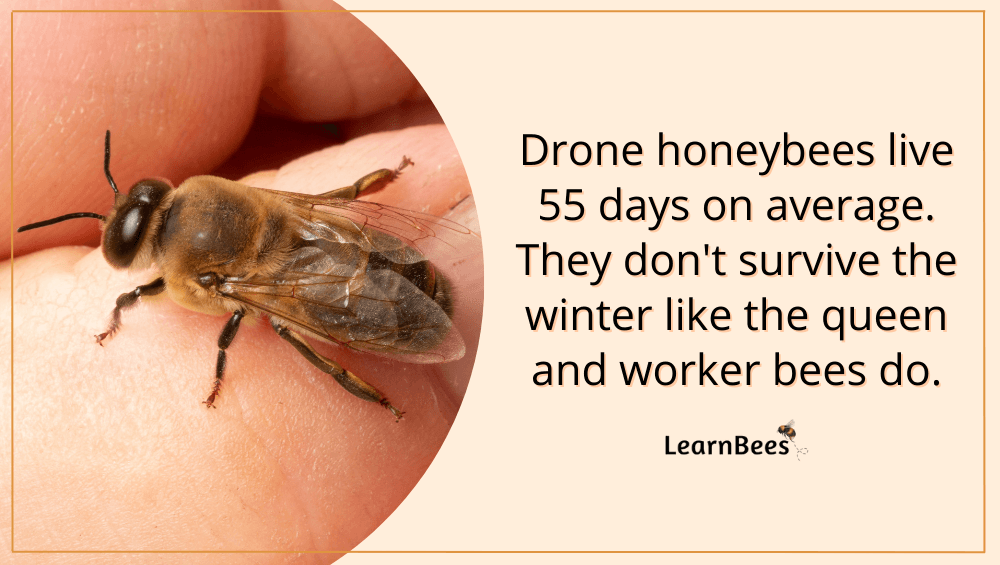
Drone honeybees live 55 days on average.
They live in the spring and summer and die off by the fall. So unlike the rest of the honeybee colony, drones don’t survive the winter.
But here’s the interesting part:
Mating is a suicide mission for drone honeybees.
They die immediately afterward because their endophallus gets stuck inside the queen. As the drone pulls away after mating, his endophallus gets ripped from his body. The loss of this essential organ leads to his sudden death.
Yikes.
So I disagree when I hear people say that drone bees have it easy. They put their lives on the line to fulfill their mating duty. Once they’ve done the job, their time comes to an abrupt end.
But what about the drones who don’t mate?
Good question. As mentioned, most drones don’t get an opportunity to mate. This means hundreds – or even thousands – of drones try and fail to mate with a queen.
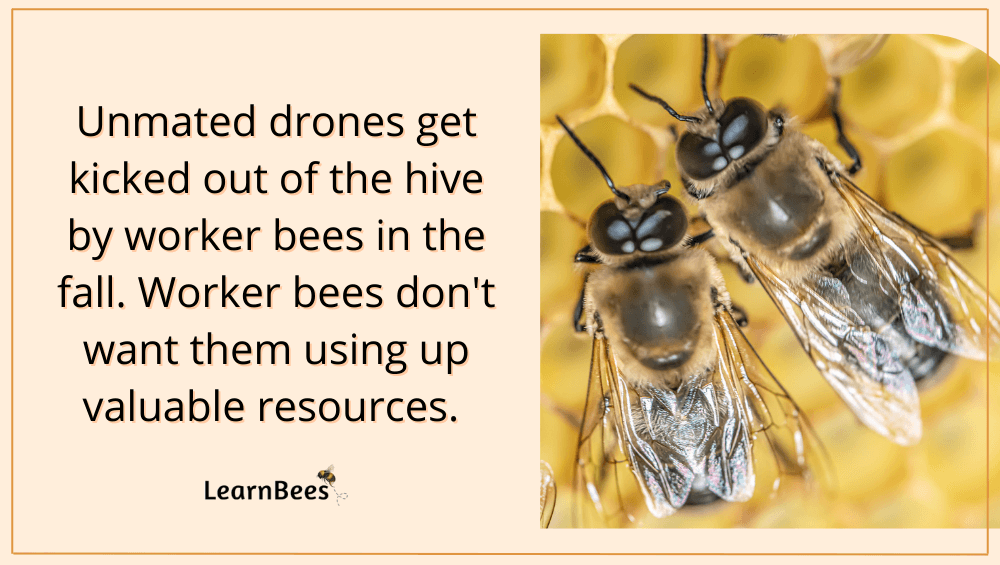
And as a result?
Back to the hive they go.
Unmated drones leave the drone congregation area and live out the rest of their life in the hive. That is, until fall approaches and they get evicted by the worker bees. This happens because food sources become scarce when cooler weather arrives.
And since drone bees don’t contribute to collecting food or making honey, they’re seen as a drain on valuable resources.
Here’s the thing:
When winter arrives, honeybees rely on their honey storage for food. Flowers become scarce as temperatures get cold. As such, the colony can’t forage for pollen and nectar from blossoms.
So the worker bees can’t have drones hanging around eating the precious honey they need for winter.
FAQs on Drone Bees
- Do drones mate with their own queen?
- Do drone bees do anything?
- How many drone bees are in a hive?
- Do drone bees leave the hive?
- Do drone bees mate in the air?
- What is the difference between a worker bee and a drone?
- What happens to drone bees in winter?
- Are all bees male except the queen?
- What do drone bees look like?
- What kills a drone bee?
- How do you identify drone cells?
- Do drone bees sting?
- Which bee is called a drone?
Do drones mate with their own queen?
No, drones don’t mate with their own queen. For one, the queen of their hive has already been mated. Queen honeybees have a short mating period that takes place not long after they hatch.
After the queen has mated, she has collected enough sperm to lay eggs for the rest of her life.
So, in short:
She never mates again.
Secondly, mating doesn’t take place inside the hive. Drones fly away from their nest and gather together in a drone congregation area. This is where they wait for queens from other colonies to fly by.
—> Go back to the FAQs on Drone Bees
More to Explore:
Do drone bees do anything?
People often ask:
What do drone bees do all day? What is a drone bee’s job?
Drones have one job that they do very well:
They mate with a queen.
This is an important job because honeybees reproduce sexually, meaning both males and females are required. Without the help of drones, honeybees would cease to exist.
That said, people often compare a drone’s single job duty to the worker bee’s. Worker bees have multiple responsibilities, such as foraging for food, making honey, and taking care of the brood.
While it may seem like worker bees have a more difficult life, it’s important to remember that they play the role they were born to do. I wouldn’t say that drones have it easy, either. They die immediately after mating because their endophallus gets torn out of their body.
That doesn’t sound too easy to me.
—> Go back to the FAQs on Drone Bees
More to Explore:
How many drone bees are in a hive?
It just depends on the hive.
For example, a honeybee hive can have anywhere from 10,000 to 60,000 bees. Worker bees make up more than 90% of the hive. There is only a single queen, and typically a couple of hundred drones.
—> Go back to the FAQs on Drone Bees
More to Explore:
Do drone bees leave the hive?
People frequently ask:
Why are drone bees kicked out of the hive? Do female bees kick out male bees?
Drone bees leave the hive to form drone congregation areas. This is where they wait for a virgin queen to fly by so they can mate with her. If they can’t successfully mate, they’ll return to the hive.
When fall arrives, the worker bees carry any remaining drones out of the hives.
Why?
Because they’re seen as a drain on resources like food. They don’t help with collecting food or making honey. So when winter comes, and food sources become scarce, the worker bees can’t afford to have drones hanging around eating the precious honey they need for winter.
—> Go back to the FAQs on Drone Bees
More to Explore:
Do drone bees mate in the air?
Yes, honeybees mate midflight. Drones form large clusters waiting for a virgin queen to fly by. Once she’s in range, multiple drones will chase her and attempt to mate.
Only a few drones will be successful. The process is very quick – lasting only a few seconds per drone.
—> Go back to the FAQs on Drone Bees
More to Explore:
What is the difference between a worker bee and a drone?
Worker bees are female bees that do the majority of the hive duties. Some of their duties include collecting pollen and nectar, making honey, and taking care of the brood.
Drone bees are male bees whose only job is to mate with a virgin queen. Once they mate, they die because their endophallus is torn out.
—> Go back to the FAQs on Drone Bees
More to Explore:
- Ground Bees: Are They a Threat to Your Yard?
- Wasps vs. Honeybees: Are They Different?
- Do Bumble Bees Bite?
What happens to drone bees in winter?
Drone honeybees don’t make it to the winter. This is because worker bees evict them from the hive in the fall. Since drones don’t help collect food or make honey, they’re seen as a drain on resources. The worker bees can’t afford to have them around eating the precious honey they need for winter.
—> Go back to the FAQs on Drone Bees
More to Explore:
Are all bees male except the queen?
No, the opposite is true. Most of the honeybees in the hive are female worker bees. Drones only make up a small portion of the hive population.
More female worker bees are necessary to complete all the hive duties. Worker bees get their name because they do most of the heavy lifting. For example, worker bees gather food, protect the hive, clean the nest, and take care of the queen.
—> Go back to the FAQs on Drone Bees
More to Explore:
- Do Carpenter Bees Pollinate?
- How Long Do Bumble Bees Live?
- Honeybees vs. Bumblebees: How Do They Compare?
What do drone bees look like? How can you tell a queen bee from a drone?
Drone bees are larger than worker bees but smaller than the queen. You can spot them by looking at their eyes. Drones have large eyes that touch each other in the middle of their head. This gives them better vision to see queen bees.
—> Go back to the FAQs on Drone Bees
More to Explore:
What kills a drone bee?
People sometimes ask, “Why do drone bees die after mating?”
Drone bees die shortly after mating. This is because their endophallus (a vital organ) gets ripped out.
But not all drones get a chance to mate. Hundreds or even thousands of drones compete with each other to reproduce with the queen. Only 10-35 drones get the opportunity to mate.
Unmated drones return to the hive only to be kicked out later once fall approaches. Once they’re evicted, they can’t fend for themselves, so they pass away shortly.
—> Go back to the FAQs on Drone Bees
More to Explore:
How do you identify drone cells?
Drone cells are larger than worker cells. You’ll typically find them on the edges of the brood chamber.
Drone cells are usually laid close together, with a rounded dome-shaped top.
As a beekeeper, you need to watch the drone brood closely. Mites prefer to feed on drones because they take longer to hatch, making them an easier food source. Drone cells also take a little longer to be capped, which gives mites more time to get into the cell and reproduce.
—> Go back to the FAQs on Drone Bees
More to Explore:
Do drone bees sting?
People often ask:
Do drone bees have stingers? Are drone bees harmless?
Drone bees are indeed harmless because they don’t have stingers. Stingers are modified egg-laying organs that only female bees have.
—> Go back to the FAQs on Drone Bees
More to Explore:
Which bee is called a drone?
People often ask, “Are there male bees in a hive?”
Yes, there are male bees in the hive. Male honeybees are called drones.
